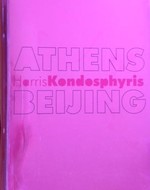


Maria Vidali
Beijing catalogue
by Ch. Kontosphyris
for the 26th Bienal
in Sao Paolo,
Hellenic ministry of Culture Publications
(Athens, 2004)
Looking for a ‘common ground’
The truth of the city always gives a special quality of the completion of its history, but of its continuity as well.
The Chinese pagoda, the timid light in the temple’s openings and their reflection reveal to us the myth that travels with them, the human existence bound with nature and the cosmos, the culture. On the other hand, the idea of the Chinese pagoda finds its completion in the immigrants’ figures. On the cold steel surface and its strong reflection there is the reality of ‘logos’, the beginning of emancipation of human reason, in the rules of our everyday life.
Does art have the role of mediator, between the ‘myth’ and the ‘logos’ ? Is it art that fumbles in the immigrants’ suitcases, full of memories, history, music, sounds, architecture, pictures, and theatre? Do all these find their own place in the new land? Where do all these cultural traces go?
During my experience, so far, in the art of time, architecture, as stated by Alberto Perez Gomez, “…since it helps shape our experience of time,’’[1] I can read the way Athens has been structured and inhabited, the way different urban fabrics have coexisted, during the centuries, creating something illogical and arbitrary at the same time. But I can also see the contemporary way of living and the appearance of an architecture isolated from the city context and its reality. Is there in our culture a common ground, composed of all sorts of traces and fragments and latent continuities so as architecture is relevant and ethical?
This could be an answer- an endemic tradition developed out of the creative encounter between two different cultures, probably the Byzantine culture and the Venetian/ French culture, from the old times until today, in specific paradigms.
On the island of Tinos in the Cyclades, which carries these two paradigm cultures, the landscape, the land itself became a common ground as the people who lived on the island and used the production of marble and stone for the needs of their everyday lives, were also led to art and to communication through that. There is a multi-cultural situation still active and valid. There are traces of different cultural paradigms, situated on a common ground (literally land, metaphorically art) that develops a creative coexistence, a continuity.
Another distinct view of dialectic creativity is to be found in the old town of Porto where the Arab sense of culture rubs shoulders with baroque splendor, where the gloss of azulehos (Arab tiles with characteristic enamel decoration) rubs shoulders with the symbolic language of the baroque.
Do we after all need places for communication, an “ interpretation of a way of life valid for our period.’[2]? Alberto Perez Gomez refers to the Tower of Babel, “ If the Tower of Babel furnishes architecture with a paradigm, this paradigm carries a warning: as we all know, the tower could not be finished- this center would not hold. By confusing the builders’ languages and scattering them abroad, across the face of the earth, God inflicted on them just the fate they had sought to avoid. One point of the story is no doubt to suggest that by themselves human beings lack the strength to furnish themselves with a center,”[3]
In Haris Kontosfiris’ work, the Chinese pagoda followed by its reflection floats on a horizon, on a stage. The 10.000 Chinese immigrants in Athens need to give their own performance on the stage of the everyday life. What might be the mediator of their ‘myth’ and ‘logos’, is ‘theatre’, a place of performance, a place of communication where their figures could reflect on somebody else’s figure.
As Dalibor Vesely explains: “ To be creative today is a different task. It requires an involvement in the way of making which is not only participatory but which can bridge the gap between the emancipated object and systems and the concrete reality of our life (world).”[4]
Τhere is a deep need in our fragmented culture to discover and articulate a common ethos. Re-affirmation of a cultural identity, but also the transposition of culture in an alien urban context and the continuity and change when tradition is changing as part of its natural course, is one of the most important issues nowadays.
The experience of the surrounding world allows us to discover a special quality of life and realize that things around us are not entirely ours, they belong to our cultural tradition that creates a history of ideas which ought to have meaning and continuity.
References:
________________________________________
1. Perez – Gomez Alberto and Paletier Louise, Architectural Representation and the Perspective Hinge,(The Mit Press), Building Dwelling and Time,p.220.
2. Harries Karsten, The Ethical Function of Architecture,(The MIT Press), Introduction: Postmodern Prelude, p.11.
3. Perez – Gomez Alberto and Paletier Louise, Architectural Representation and the Perspective Hinge,(The Mit Press), The Voices of Space,p.184.
4. Vesely Dalibor, Architecture, Communication and the real World, Scroope no.6, Lectures at the Cambridge School of Architecture.